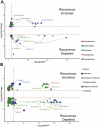Crohn's Disease Differentially Affects Region-Specific Composition and Aerotolerance Profiles of Mucosally Adherent Bacteria
- PMID: 32469069
- PMCID: PMC7676424
- DOI: 10.1093/ibd/izaa103
Crohn's Disease Differentially Affects Region-Specific Composition and Aerotolerance Profiles of Mucosally Adherent Bacteria
Abstract
Background: The intestinal microbiota play a key role in the onset, progression, and recurrence of Crohn disease (CD). Most microbiome studies assay fecal material, which does not provide region-specific information on mucosally adherent bacteria that directly interact with host systems. Changes in luminal oxygen have been proposed as a contributor to CD dybiosis.
Methods: The authors generated 16S rRNA data using colonic and ileal mucosal bacteria from patients with CD and without inflammatory bowel disease. We developed profiles reflecting bacterial abundance within defined aerotolerance categories. Bacterial diversity, composition, and aerotolerance profiles were compared across intestinal regions and disease phenotypes.
Results: Bacterial diversity decreased in CD in both the ileum and the colon. Aerotolerance profiles significantly differed between intestinal segments in patients without inflammatory bowel disease, although both were dominated by obligate anaerobes, as expected. In CD, high relative levels of obligate anaerobes were maintained in the colon and increased in the ileum. Relative abundances of similar and distinct taxa were altered in colon and ileum. Notably, several obligate anaerobes, such as Bacteroides fragilis, dramatically increased in CD in one or both intestinal segments, although specific increasing taxa varied across patients. Increased abundance of taxa from the Proteobacteria phylum was found only in the ileum. Bacterial diversity was significantly reduced in resected tissues of patients who developed postoperative disease recurrence across 2 independent cohorts, with common lower abundance of bacteria from the Bacteroides, Streptococcus, and Blautia genera.
Conclusions: Mucosally adherent bacteria in the colon and ileum show distinct alterations in CD that provide additional insights not revealed in fecal material.
Keywords: Crohn disease; IBD; microbiome; mucosally adherent microbiota; postoperative CD.
© 2020 Crohn’s & Colitis Foundation. Published by Oxford University Press. All rights reserved. For permissions, please e-mail: journals.permissions@oup.com.
Figures



Similar articles
-
Bacterial Mucosa-associated Microbiome in Inflamed and Proximal Noninflamed Ileum of Patients With Crohn's Disease.Inflamm Bowel Dis. 2021 Jan 1;27(1):12-24. doi: 10.1093/ibd/izaa107. Inflamm Bowel Dis. 2021. PMID: 32448900 Free PMC article.
-
Influence of Crohn's disease related polymorphisms in innate immune function on ileal microbiome.PLoS One. 2019 Feb 28;14(2):e0213108. doi: 10.1371/journal.pone.0213108. eCollection 2019. PLoS One. 2019. PMID: 30818349 Free PMC article.
-
IL23R-Protective Coding Variant Promotes Beneficial Bacteria and Diversity in the Ileal Microbiome in Healthy Individuals Without Inflammatory Bowel Disease.J Crohns Colitis. 2019 Mar 30;13(4):451-461. doi: 10.1093/ecco-jcc/jjy188. J Crohns Colitis. 2019. PMID: 30445599
-
Gut microbiota in Crohn's disease pathogenesis.World J Gastroenterol. 2025 Feb 14;31(6):101266. doi: 10.3748/wjg.v31.i6.101266. World J Gastroenterol. 2025. PMID: 39958442 Free PMC article. Review.
-
Effect of Bacteroides on Crohn's disease.Z Gastroenterol. 2025 Apr;63(4):393-402. doi: 10.1055/a-2435-2659. Epub 2024 Nov 25. Z Gastroenterol. 2025. PMID: 39586813 Review. English.
Cited by
-
Characteristics of intestinal microbiota in C57BL/6 mice with non-alcoholic fatty liver induced by high-fat diet.Front Microbiol. 2022 Dec 22;13:1051200. doi: 10.3389/fmicb.2022.1051200. eCollection 2022. Front Microbiol. 2022. PMID: 36620001 Free PMC article.
-
Bacillus siamensis Targeted Screening from Highly Colitis-Resistant Pigs Can Alleviate Ulcerative Colitis in Mice.Research (Wash D C). 2024 Jul 16;7:0415. doi: 10.34133/research.0415. eCollection 2024. Research (Wash D C). 2024. PMID: 39015206 Free PMC article.
-
Systematic Review: The Gut Microbiome and Its Potential Clinical Application in Inflammatory Bowel Disease.Microorganisms. 2021 Apr 30;9(5):977. doi: 10.3390/microorganisms9050977. Microorganisms. 2021. PMID: 33946482 Free PMC article. Review.
-
Intestinal Microbiota and Gene Expression Reveal Similarity and Dissimilarity Between Immune-Mediated Colitis and Ulcerative Colitis.Front Oncol. 2021 Oct 27;11:763468. doi: 10.3389/fonc.2021.763468. eCollection 2021. Front Oncol. 2021. PMID: 34778085 Free PMC article.
-
Reframing anorexia nervosa as a metabo-psychiatric disorder.Trends Endocrinol Metab. 2021 Oct;32(10):752-761. doi: 10.1016/j.tem.2021.07.010. Epub 2021 Aug 20. Trends Endocrinol Metab. 2021. PMID: 34426039 Free PMC article. Review.
References
-
- Eckburg PB, Relman DA. The role of microbes in Crohn’s disease. Clin Infect Dis. 2007;44:256–262. - PubMed
-
- Elson CO, Cong Y, McCracken VJ, et al. . Experimental models of inflammatory bowel disease reveal innate, adaptive, and regulatory mechanisms of host dialogue with the microbiota. Immunol Rev. 2005;206:260–276. - PubMed
Publication types
MeSH terms
Substances
Grants and funding
LinkOut - more resources
Full Text Sources
Medical
Molecular Biology Databases

